Tambahan :
Children of the Great War
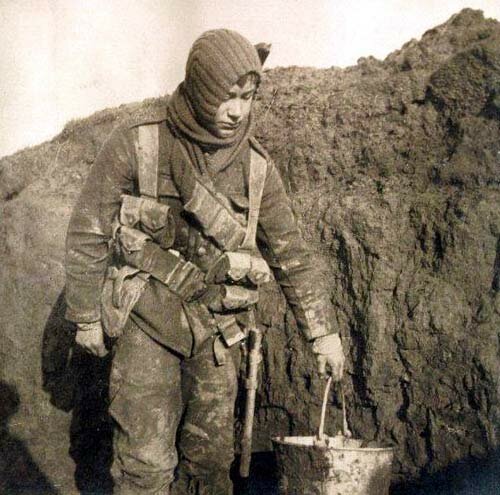
ll armies in the Great War used kid soldiers. In the beginning of the war the enthousiasm to join the battle was so great that young boys (and even girls) could hardly be stopped to enlist.
Recruiting Officers in all countries closed their eyes when eager children clearly under the required age - 18 years old - showed up to join their armies.
At the end of the war children were even more welcome in the ranks, as the Great Mincing Machine continued to require human bodies with an astonishing need.
Hardly trained the kids were send to the trenches in Belgium, France, Russia and Turkey, where they mingled with the oldier soldiers - and died with them.
By Rob Ruggenberg
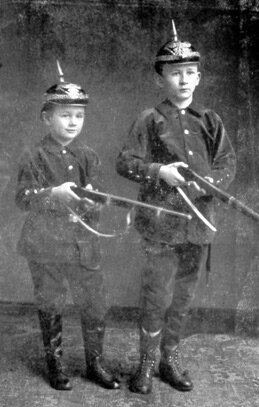
German children playing soldier.
Picture made in 1914. The boy on the left definitely is too young, but his brother will be wanted for the German army in the next years.
Photograph taken from Krieg dem Kriege (1924), the famous anti-war book by Ernst Friedrich.
Pictures of children playing war are abundant in all countries in this period Unfortunately the Great War gave many of them a chance to revert play to reality.
German Recruits
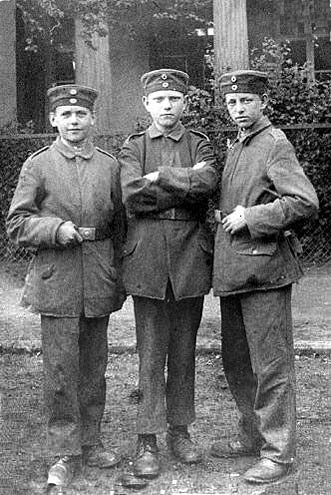
This picture is probably made in 1917.
Because of a higher birthrate Germany had more boys at her disposal than other countries. That's why the Germans were able to increase their armies until the spring of 1918.
British Recruits
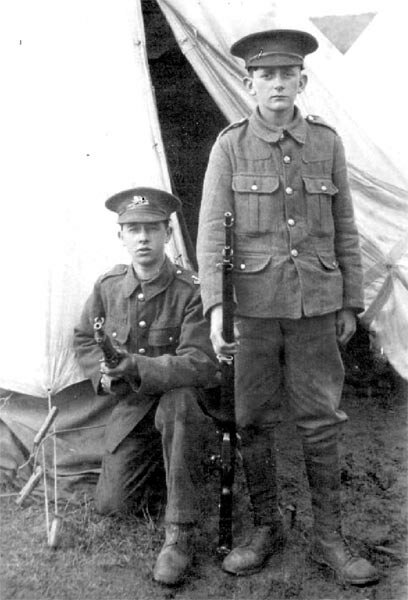
Young soldiers of the Lancaster Regiment outside a bell tent in a trainingcamp.
With the rapid expansion of the British Army after the outbreak of the war there was not enough equipment to go around. The standing soldier has the basic uniform complete with puttees. However, he has neither a cap badge or shoulder titles. The kneeling soldier has acquired all of his badges but his uniform is incomplete as he lacks puttees.
Note that both the boys are holding old fashioned rifles, at this time these may have been their battalion’s only weapons.
Young French Recruits-to-be |

In France the enthousiasm to join was enormous. The picture shows young Frenchmen on their way to the recruiting office. A quote from the British weekly The War Illustrated on 28th May, 1915, describing a battle near La Bassée:
"Two French battalions of the line headed the charge, mostly formed of the youngest recruits. The Bavarians held their ground and fought gamely. The youngest soldiers of France rushed the machine-guns, at no matter what loss, emptied their magazines into the crowded trenches, and then jumped in and fought with the bayonet."
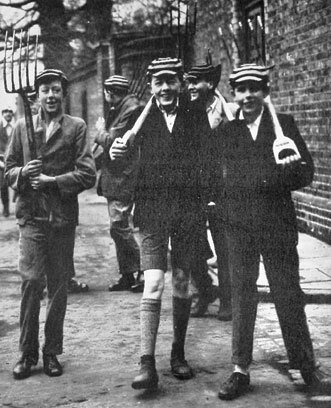
The story goes that under-age youths wishing to enlist during the war used to write the number eighteen on a piece of paper placed into the sole of their shoe. This was done in order to deceive the enrollment officer when asked if they were over 18...
The British army resisted any suggestion that recruits prove their age by producing their birth certificates when enlisting. It was a scandal which provoked complaints in Parliament. The National Service League also protested, claiming that around 15% of wartime recruits were underage.
The army eventually allowed underage soldiers to be reclaimed by their parents.   According to populair belief the youngest boy to enlist in the allied armies was John Condon from Waterford, Ireland. He was supposedly 12 years old. According to populair belief the youngest boy to enlist in the allied armies was John Condon from Waterford, Ireland. He was supposedly 12 years old.
John Condon went with the Royal Irish Regiment to Flanders. He died on 24th May 1915, during a German gas-attack near Ypres.
Picture right: Gravestone nr. 6322 at the Poelkapelle British Cemetery in Belgium, mentions his age as 14.
 Investigations in 2002 by Aurel Sercu from Ypres, Flanders, revealed that someone else may be buried in John Condon's grave. Sercu also found indications that John Condon was in fact 18 years old. Investigations in 2002 by Aurel Sercu from Ypres, Flanders, revealed that someone else may be buried in John Condon's grave. Sercu also found indications that John Condon was in fact 18 years old.
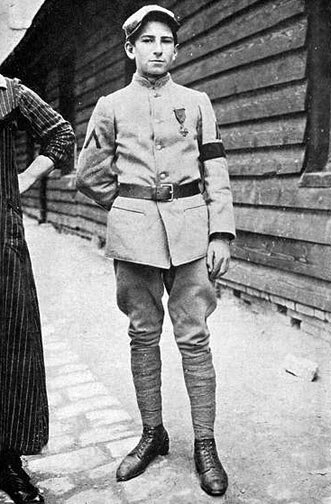
French corporal proudly posing for the camera. Newspapers told the public that the boy had joined the army when he was 14 years old. He was wounded and he had won the French Cross of War.

The boy in the middle is '15 years old hero' Edouard Mina from Lyon, France. Edouard is an orphan. His 'adoption-parents' next to him call him Petite Bleu, little blue, because of his blue pants that every poilu (common soldier) wears.
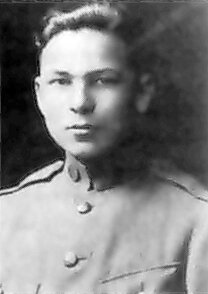
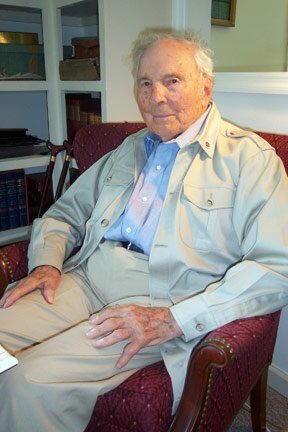
Frank W. Buckles enlisted in the American army at age 16 in 1917. He is still alive and probably the oldest veteran in the world (see picture on the right).
During his summer vacation from school he went to the Marine Corps recruiting office to enlist, told them he was 21, but he was turned down: too small. He tried the Navy: too flatfooted.
He then went to the Army and they accepted him. "The old sergeant advised me that the Ambulance Service was the quickest way to get to France because the French were begging for ambulance services".
In France he served at several locations. After Armistice Day he was assigned to a prisoner-of-war escort company to return prisoners back to Germany.
In World War II, while working for a steamship company in the Philippine Islands, the Japanese army seized him and he stayed in a prisoner-of-war camp for more than three years.
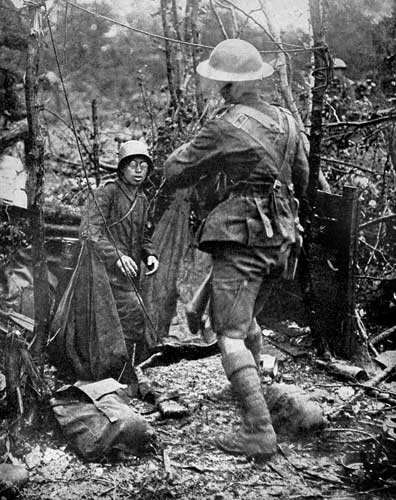
Famous picture of the surrender of a young German soldier. The boy climbs out of his shelter and gives himself up to a Scotch soldier.
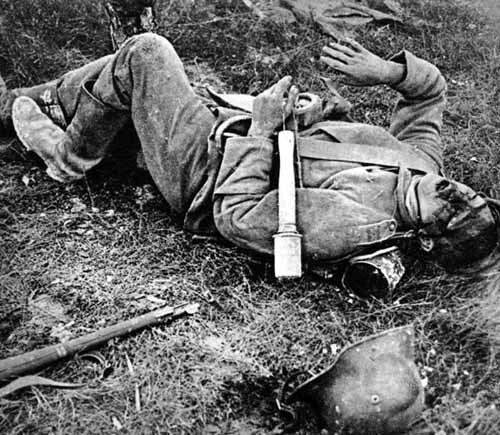
Young German soldier, stiffened in the death. At his side an unused handgrenade, his gun and his helmet.
Sometimes whole schoolclasses enlisted together - and died together, as can be read in Remarque's famous war-novel All Quiet on the Western Front.
The Langemark cemetery in Flanders, Belgium, holds the bodies of numerous German kid-soldiers.

Young and old together, on their way to the trenches. These are soldiers of the 10th Battalion of the Royal Fusiliers.
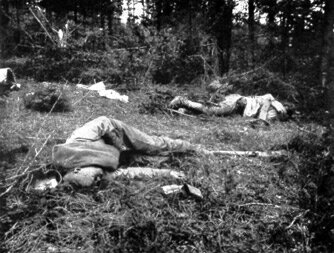
French boys, fallen between the brushwood.
|